Inficon Transpector CPM User Manual
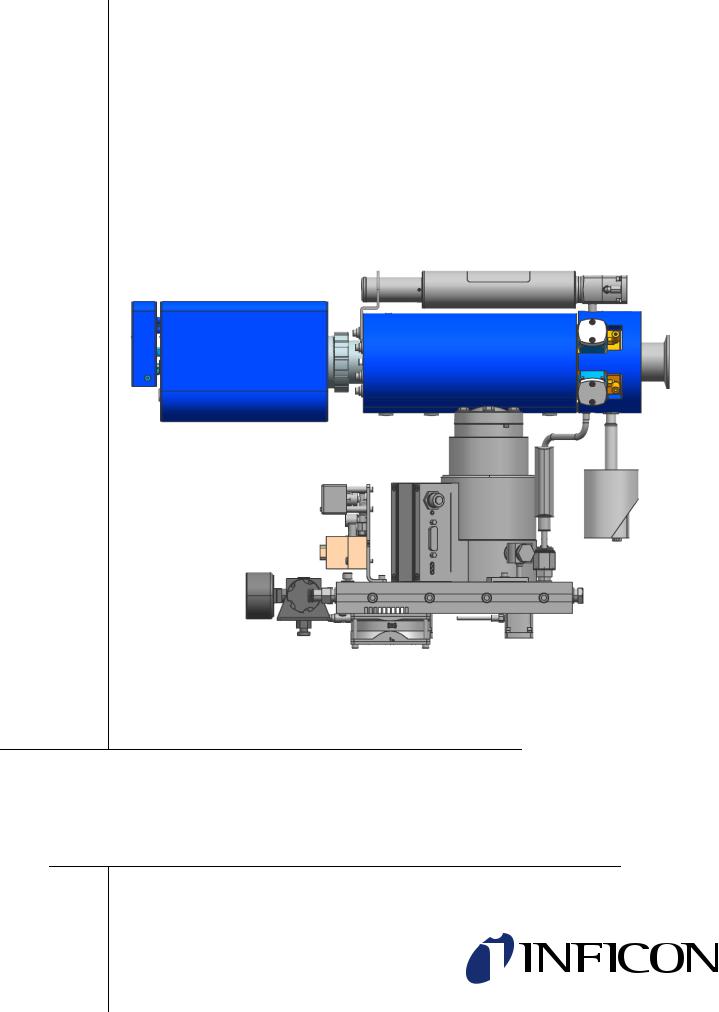
Cover Page
O P E R A T I N G M A N U A L
Transpector® CPM
Compact Process Monitor
PN 074-641-P1B
Trademarks
The trademarks of the products mentioned in this manual are held by the companies that produce them.
INFICON®, Transpector®, and FabGuard® are registered trademarks and FabGuard Explorer™ is a trademark of INFICON.
Windows®, Windows NT® and Microsoft® are registered trademarks of Microsoft Corporation.
Teflon® is a registered trademark of DuPont Co.
Swagelok® is a registered trademark of Swagelok Co.
All other brand and product names are trademarks or registered trademarks of their respective companies.
Disclaimer
The information contained in this manual is believed to be accurate and reliable. However, INFICON assumes no responsibility for its use and shall not be liable for any special, incidental, or consequential damages related to the use of this product.
Due to our continuing program of product improvements, specifications are subject to change without notice.
Copyright
©2016 All rights reserved.
Reproduction or adaptation of any part of this document without permission is unlawful.


Warranty
WARRANTY AND LIABILITY - LIMITATION: Seller warrants the products manufactured by it, or by an affiliated company and sold by it, and described on the reverse hereof, to be, for the period of warranty coverage specified below, free from defects of materials or workmanship under normal proper use and service. The period of warranty coverage is specified for the respective products in the respective Seller instruction manuals for those products but shall not be less than one (1) year from the date of shipment thereof by Seller. Seller's liability under this warranty is limited to such of the above products or parts thereof as are returned, transportation prepaid, to Seller's plant, not later than thirty (30) days after the expiration of the period of warranty coverage in respect thereof and are found by Seller's examination to have failed to function properly because of defective workmanship or materials and not because of improper installation or misuse and is limited to, at Seller's election, either (a) repairing and returning the product or part thereof, or (b) furnishing a replacement product or part thereof, transportation prepaid by Seller in either case. In the event Buyer discovers or learns that a product does not conform to warranty, Buyer shall immediately notify Seller in writing of such non-conformity, specifying in reasonable detail the nature of such non-conformity. If Seller is not provided with such written notification, Seller shall not be liable for any further damages which could have been avoided if Seller had been provided with immediate written notification.
THIS WARRANTY IS MADE AND ACCEPTED IN LIEU OF ALL OTHER WARRANTIES, EXPRESS OR IMPLIED, WHETHER OF MERCHANTABILITY OR OF FITNESS FOR A PARTICULAR PURPOSE OR OTHERWISE, AS BUYER'S EXCLUSIVE REMEDY FOR ANY DEFECTS IN THE PRODUCTS TO BE SOLD HEREUNDER. All other obligations and liabilities of Seller, whether in contract or tort (including negligence) or otherwise, are expressly EXCLUDED. In no event shall Seller be liable for any costs, expenses or damages, whether direct or indirect, special, incidental, consequential, or other, on any claim of any defective product, in excess of the price paid by Buyer for the product plus return transportation charges prepaid.
No warranty is made by Seller of any Seller product which has been installed, used or operated contrary to Seller's written instruction manual or which has been subjected to misuse, negligence or accident or has been repaired or altered by anyone other than Seller or which has been used in a manner or for a purpose for which the Seller product was not designed nor against any defects due to plans or instructions supplied to Seller by or for Buyer.
This manual is intended for private use by INFICON® Inc. and its customers. Contact INFICON before reproducing its contents.
NOTE: These instructions do not provide for every contingency that may arise in connection with the installation, operation or maintenance of this equipment. Should you require further assistance, please contact INFICON.
www.inficon.com reachus@inficon.com
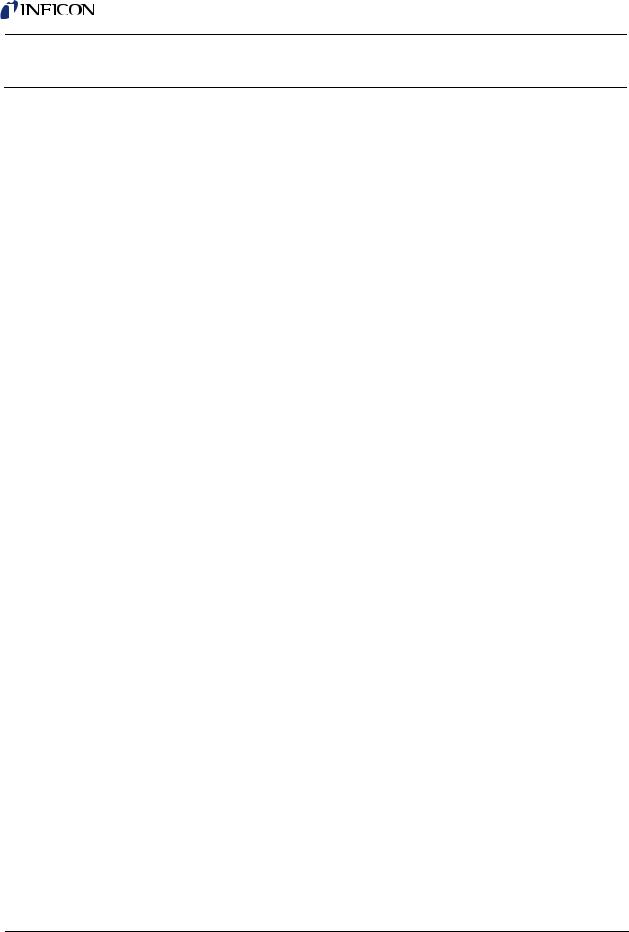
Transpector CPM Operating Manual
Table Of Contents
Cover Page
Trademarks
Disclaimer
Copyright
Declaration Of Conformity
Warranty
Chapter 1
Getting Started
1.1 General Safety Information. . . . . . . . . . . . . . . . . . . . . . . . . . . . . . . . . . . . . .1-1 1.2 Purpose of Transpector CPM. . . . . . . . . . . . . . . . . . . . . . . . . . . . . . . . . . . .1-2 1.2.1 Description of the Transpector CPM . . . . . . . . . . . . . . . . . . . . . . . . . . . . . .1-2 1.3 Using this Operating Manual . . . . . . . . . . . . . . . . . . . . . . . . . . . . . . . . . . . .1-3 1.4 How to Contact INFICON. . . . . . . . . . . . . . . . . . . . . . . . . . . . . . . . . . . . . . .1-4 1.4.1 Returning Transpector CPM to INFICON. . . . . . . . . . . . . . . . . . . . . . . . . . .1-4 1.5 Transpector CPM Performance Specifications. . . . . . . . . . . . . . . . . . . . . . .1-5 1.5.1 General Specifications . . . . . . . . . . . . . . . . . . . . . . . . . . . . . . . . . . . . . . . . .1-5 1.5.2 Hex Block Orifice Sampling Inlets . . . . . . . . . . . . . . . . . . . . . . . . . . . . . . . .1-7 1.5.3 Atmospheric Pressure (Capillary) Sampling. . . . . . . . . . . . . . . . . . . . . . . . .1-8 1.6 Physical Requirements. . . . . . . . . . . . . . . . . . . . . . . . . . . . . . . . . . . . . . . . .1-9 1.6.1 Physical Dimensions . . . . . . . . . . . . . . . . . . . . . . . . . . . . . . . . . . . . . . . . . .1-9 1.6.2 Weight . . . . . . . . . . . . . . . . . . . . . . . . . . . . . . . . . . . . . . . . . . . . . . . . . . . .1-10 1.6.3 Ventilation Requirements . . . . . . . . . . . . . . . . . . . . . . . . . . . . . . . . . . . . . .1-10 1.7 Electrical Power Requirements . . . . . . . . . . . . . . . . . . . . . . . . . . . . . . . . .1-10 1.7.1 Required Supply Voltage . . . . . . . . . . . . . . . . . . . . . . . . . . . . . . . . . . . . . .1-10 1.7.1.1 Acceptable Supply Voltage Range. . . . . . . . . . . . . . . . . . . . . . . . . . . . . . .1-10 1.7.1.2 Required Frequency. . . . . . . . . . . . . . . . . . . . . . . . . . . . . . . . . . . . . . . . . .1-10 1.7.1.3 Power Rating . . . . . . . . . . . . . . . . . . . . . . . . . . . . . . . . . . . . . . . . . . . . . . .1-10 1.7.1.4 Fuse Rating . . . . . . . . . . . . . . . . . . . . . . . . . . . . . . . . . . . . . . . . . . . . . . . .1-11 1.7.1.5 Overvoltage Category. . . . . . . . . . . . . . . . . . . . . . . . . . . . . . . . . . . . . . . . .1-11 1.7.1.6 Electrical Connections . . . . . . . . . . . . . . . . . . . . . . . . . . . . . . . . . . . . . . . .1-11
1.8 Nitrogen Purge Gas (Corrosive System Only) . . . . . . . . . . . . . . . . . . . . . .1-11 1.9 Exhaust Gas. . . . . . . . . . . . . . . . . . . . . . . . . . . . . . . . . . . . . . . . . . . . . . . .1-12 1.10 Air Pressure Requirements . . . . . . . . . . . . . . . . . . . . . . . . . . . . . . . . . . . .1-13 1.10.1 Required Air Pressure . . . . . . . . . . . . . . . . . . . . . . . . . . . . . . . . . . . . . . . .1-13 1.10.2 Air Pressure Range . . . . . . . . . . . . . . . . . . . . . . . . . . . . . . . . . . . . . . . . . .1-13
TOC – 1

Transpector CPM Operating Manual
1.10.3 Moisture Content of Compressed Air Supply. . . . . . . . . . . . . . . . . . . . . . .1-13
1.10.4 Air Pressure Connections. . . . . . . . . . . . . . . . . . . . . . . . . . . . . . . . . . . . . .1-13
1.11 Vacuum Requirements. . . . . . . . . . . . . . . . . . . . . . . . . . . . . . . . . . . . . . . .1-14
1.11.1 Required Vacuum. . . . . . . . . . . . . . . . . . . . . . . . . . . . . . . . . . . . . . . . . . . .1-14
1.11.2 Acceptable Range Of Vacuum. . . . . . . . . . . . . . . . . . . . . . . . . . . . . . . . . .1-14
1.12 Environmental Requirements. . . . . . . . . . . . . . . . . . . . . . . . . . . . . . . . . . .1-14
1.12.1 Use. . . . . . . . . . . . . . . . . . . . . . . . . . . . . . . . . . . . . . . . . . . . . . . . . . . . . . .1-14
1.12.2 Altitude Range . . . . . . . . . . . . . . . . . . . . . . . . . . . . . . . . . . . . . . . . . . . . . .1-14
1.12.3 Maximum Humidity. . . . . . . . . . . . . . . . . . . . . . . . . . . . . . . . . . . . . . . . . . .1-14
1.12.4 Pollution Degree. . . . . . . . . . . . . . . . . . . . . . . . . . . . . . . . . . . . . . . . . . . . .1-14
1.12.5 Maximum Operating Temperature . . . . . . . . . . . . . . . . . . . . . . . . . . . . . . .1-14
1.12.6 Minimum Operating Temperatures. . . . . . . . . . . . . . . . . . . . . . . . . . . . . . .1-14
1.12.7 Clean Room Requirements . . . . . . . . . . . . . . . . . . . . . . . . . . . . . . . . . . . .1-15
1.12.8 Anti-Static Conditions. . . . . . . . . . . . . . . . . . . . . . . . . . . . . . . . . . . . . . . . .1-15
1.13 Computer System Requirements. . . . . . . . . . . . . . . . . . . . . . . . . . . . . . . .1-15
1.13.1 Operating System. . . . . . . . . . . . . . . . . . . . . . . . . . . . . . . . . . . . . . . . . . . .1-15
Chapter 2
Installation
2.1 Installation Overview . . . . . . . . . . . . . . . . . . . . . . . . . . . . . . . . . . . . . . . . . .2-1
2.2Transpector Electronics Module, Heat Guard, and Cable Box Installation .2-2
2.2.1 Attach Transpector Electronics Module . . . . . . . . . . . . . . . . . . . . . . . . . . . .2-2
2.2.2 Attach Heat Guard . . . . . . . . . . . . . . . . . . . . . . . . . . . . . . . . . . . . . . . . . . . .2-3
2.2.3 Attach Cable Box . . . . . . . . . . . . . . . . . . . . . . . . . . . . . . . . . . . . . . . . . . . . .2-4
2.3 Sniffer Installation. . . . . . . . . . . . . . . . . . . . . . . . . . . . . . . . . . . . . . . . . . . . .2-5
2.4 Mounting the Pumping System . . . . . . . . . . . . . . . . . . . . . . . . . . . . . . . . . .2-5
2.4.1 Installing the Support Kit . . . . . . . . . . . . . . . . . . . . . . . . . . . . . . . . . . . . . . .2-6
2.4.2 Atmospheric Support Frame . . . . . . . . . . . . . . . . . . . . . . . . . . . . . . . . . . . .2-7
2.5 CPM Controller Installation. . . . . . . . . . . . . . . . . . . . . . . . . . . . . . . . . . . . . .2-7
2.6 Transpector Cable Box Connections . . . . . . . . . . . . . . . . . . . . . . . . . . . . . .2-9
2.7 CPM Foreline Pump Installation. . . . . . . . . . . . . . . . . . . . . . . . . . . . . . . . .2-11
2.8 Software Installation. . . . . . . . . . . . . . . . . . . . . . . . . . . . . . . . . . . . . . . . . .2-11
Chapter 3
Connecting Transpector CPM
3.1 Introduction. . . . . . . . . . . . . . . . . . . . . . . . . . . . . . . . . . . . . . . . . . . . . . . . . .3-1
3.2 General Networking Information. . . . . . . . . . . . . . . . . . . . . . . . . . . . . . . . . .3-1
3.2.1 IP Addresses . . . . . . . . . . . . . . . . . . . . . . . . . . . . . . . . . . . . . . . . . . . . . . . .3-1
3.2.2 Subnetworking . . . . . . . . . . . . . . . . . . . . . . . . . . . . . . . . . . . . . . . . . . . . . . .3-2
3.3 Transpector CPM IP Address. . . . . . . . . . . . . . . . . . . . . . . . . . . . . . . . . . . .3-2
TOC – 2

Transpector CPM Operating Manual
3.3.1Using the INFICON Mass Spectrometer Search Utility to
Change the Transpector CPM IP Address. . . . . . . . . . . . . . . . . . . . . . . . . .3-3 3.3.1.1 Change IP Address . . . . . . . . . . . . . . . . . . . . . . . . . . . . . . . . . . . . . . . . . . .3-4 3.3.1.2 Launch Web UI. . . . . . . . . . . . . . . . . . . . . . . . . . . . . . . . . . . . . . . . . . . . . . .3-5 3.3.1.3 Find Device. . . . . . . . . . . . . . . . . . . . . . . . . . . . . . . . . . . . . . . . . . . . . . . . . .3-5 3.3.1.4 Show Settings. . . . . . . . . . . . . . . . . . . . . . . . . . . . . . . . . . . . . . . . . . . . . . . .3-5
3.4 Connecting Transpector CPM . . . . . . . . . . . . . . . . . . . . . . . . . . . . . . . . . . .3-6 3.4.1 Connecting a Single Transpector CPM . . . . . . . . . . . . . . . . . . . . . . . . . . . .3-6 3.4.1.1 Single Transpector CPM Direct Connection Installation. . . . . . . . . . . . . . . .3-6 3.4.1.2 Installing a Single Transpector CPM on an Existing Local Network. . . . . . .3-6 3.4.2 Installing Multiple Transpector CPM Sensors. . . . . . . . . . . . . . . . . . . . . . . .3-7 3.4.2.1 Installing Multiple Transpector CPM Directly to a Host Computer . . . . . . . .3-7 3.4.2.2 Installing Multiple Transpector CPM on an Existing Local Network . . . . . . .3-7
3.5 Changing the Computer IP Address. . . . . . . . . . . . . . . . . . . . . . . . . . . . . . .3-8 3.5.1 Windows 7 . . . . . . . . . . . . . . . . . . . . . . . . . . . . . . . . . . . . . . . . . . . . . . . . . .3-8
Chapter 4
How the CPM System Works
4.1 CPM Components . . . . . . . . . . . . . . . . . . . . . . . . . . . . . . . . . . . . . . . . . . . .4-1 4.2 Theory of Operation . . . . . . . . . . . . . . . . . . . . . . . . . . . . . . . . . . . . . . . . . . .4-2 4.3 Instrument Overview. . . . . . . . . . . . . . . . . . . . . . . . . . . . . . . . . . . . . . . . . . .4-2 4.3.1 Input/Output (Aux I/O) . . . . . . . . . . . . . . . . . . . . . . . . . . . . . . . . . . . . . . . . .4-2 4.3.1.1 CPM Aux I/O Connector. . . . . . . . . . . . . . . . . . . . . . . . . . . . . . . . . . . . . . . .4-3 4.3.1.2 Two Digital Inputs. . . . . . . . . . . . . . . . . . . . . . . . . . . . . . . . . . . . . . . . . . . . .4-3 4.3.1.3 One Status Relay Output . . . . . . . . . . . . . . . . . . . . . . . . . . . . . . . . . . . . . . .4-3 4.3.1.4 One Analog Input . . . . . . . . . . . . . . . . . . . . . . . . . . . . . . . . . . . . . . . . . . . . .4-4 4.3.2 Ultra-High Vacuum System . . . . . . . . . . . . . . . . . . . . . . . . . . . . . . . . . . . . .4-4 4.3.2.1 Foreline Subsystem . . . . . . . . . . . . . . . . . . . . . . . . . . . . . . . . . . . . . . . . . . .4-5 4.3.3 Heater(s) Subsystem . . . . . . . . . . . . . . . . . . . . . . . . . . . . . . . . . . . . . . . . . .4-5 4.3.4 CPM Controller Subsystem . . . . . . . . . . . . . . . . . . . . . . . . . . . . . . . . . . . . .4-5 4.3.5 Solenoid Valves . . . . . . . . . . . . . . . . . . . . . . . . . . . . . . . . . . . . . . . . . . . . . .4-6 4.3.6 Sensor and Transpector Electronics Module Subsystem. . . . . . . . . . . . . . .4-7
4.4 Application . . . . . . . . . . . . . . . . . . . . . . . . . . . . . . . . . . . . . . . . . . . . . . . . . .4-8 4.5 Sample Inlet Systems and Examples of Use . . . . . . . . . . . . . . . . . . . . . . . .4-9 4.5.1 Inlet System . . . . . . . . . . . . . . . . . . . . . . . . . . . . . . . . . . . . . . . . . . . . . . . . .4-9 4.5.2 High Pressure Sampling: Orifice Bypass (V4) . . . . . . . . . . . . . . . . . . . . . .4-12 4.5.3 Dual-Capillary Sampling Option . . . . . . . . . . . . . . . . . . . . . . . . . . . . . . . . .4-13 4.6 Advice and Tips . . . . . . . . . . . . . . . . . . . . . . . . . . . . . . . . . . . . . . . . . . . . .4-14 4.6.1 Achieving Good Base Pressure in the CPM. . . . . . . . . . . . . . . . . . . . . . . .4-14 4.6.2 Avoiding Trapped Gas when Sampling Valves are Closed . . . . . . . . . . . .4-14
TOC – 3

Transpector CPM Operating Manual
Chapter 5
Theory and Application Guide
5.1 Theory of Operation . . . . . . . . . . . . . . . . . . . . . . . . . . . . . . . . . . . . . . . . . . .5-1
5.2 Sensors . . . . . . . . . . . . . . . . . . . . . . . . . . . . . . . . . . . . . . . . . . . . . . . . . . . .5-1
5.2.1 The Ion Source. . . . . . . . . . . . . . . . . . . . . . . . . . . . . . . . . . . . . . . . . . . . . . .5-2
5.2.2 The Quadrupole Mass Filter. . . . . . . . . . . . . . . . . . . . . . . . . . . . . . . . . . . . .5-4
5.2.2.1 Scanning Characteristics . . . . . . . . . . . . . . . . . . . . . . . . . . . . . . . . . . . . . . .5-6
5.2.2.2 The Zero Blast . . . . . . . . . . . . . . . . . . . . . . . . . . . . . . . . . . . . . . . . . . . . . . .5-7
5.2.3 The Ion Detector. . . . . . . . . . . . . . . . . . . . . . . . . . . . . . . . . . . . . . . . . . . . . .5-8
5.2.3.1 The Electron Multiplier (EM) Detector . . . . . . . . . . . . . . . . . . . . . . . . . . . . .5-8
5.2.3.2 The Continuous Dynode Electron Multiplier/Faraday Cup Detector. . . . . . .5-9
5.3 How to Interpret The Result . . . . . . . . . . . . . . . . . . . . . . . . . . . . . . . . . . . .5-11
5.3.1 Qualitative Interpretation Of Mass Spectra . . . . . . . . . . . . . . . . . . . . . . . .5-11
5.3.1.1 Ionization Process . . . . . . . . . . . . . . . . . . . . . . . . . . . . . . . . . . . . . . . . . . .5-13
5.3.1.2 Isotope Ratios . . . . . . . . . . . . . . . . . . . . . . . . . . . . . . . . . . . . . . . . . . . . . .5-15
5.3.1.3 Electron Energy Effects . . . . . . . . . . . . . . . . . . . . . . . . . . . . . . . . . . . . . . .5-17
5.3.1.4 A Qualitative Interpretation Guide . . . . . . . . . . . . . . . . . . . . . . . . . . . . . . .5-19
5.3.1.5 Dry Etching Chemistries. . . . . . . . . . . . . . . . . . . . . . . . . . . . . . . . . . . . . . .5-22
5.3.1.6 Tungsten CVD . . . . . . . . . . . . . . . . . . . . . . . . . . . . . . . . . . . . . . . . . . . . . .5-24
5.3.1.7 Copper MOCVD. . . . . . . . . . . . . . . . . . . . . . . . . . . . . . . . . . . . . . . . . . . . .5-25
5.3.2Quantitative Interpretation of Mass Spectra
(Calculating Partial Pressures). . . . . . . . . . . . . . . . . . . . . . . . . . . . . . . . . .5-26
5.3.3 Additional Information For Interpreting Mass Spectra . . . . . . . . . . . . . . . .5-32
5.3.3.1 Ion Source Characteristics. . . . . . . . . . . . . . . . . . . . . . . . . . . . . . . . . . . . .5-32
5.3.3.2 Scanning Characteristics . . . . . . . . . . . . . . . . . . . . . . . . . . . . . . . . . . . . . .5-33
5.3.3.3 Fragmentation Factors. . . . . . . . . . . . . . . . . . . . . . . . . . . . . . . . . . . . . . . .5-34
Chapter 6
Operation
6.1 HexBlock . . . . . . . . . . . . . . . . . . . . . . . . . . . . . . . . . . . . . . . . . . . . . . . . . . .6-1
6.1.1 HexBlock Inlet . . . . . . . . . . . . . . . . . . . . . . . . . . . . . . . . . . . . . . . . . . . . . . .6-2
6.1.1.1 Hex Block Process Connections . . . . . . . . . . . . . . . . . . . . . . . . . . . . . . . . .6-3
6.1.2 Calibration Option. . . . . . . . . . . . . . . . . . . . . . . . . . . . . . . . . . . . . . . . . . . . .6-3
6.1.2.1 High Mass FC5311 Tuning Reference. . . . . . . . . . . . . . . . . . . . . . . . . . . . .6-4
6.1.3 Process Gauge (CDG). . . . . . . . . . . . . . . . . . . . . . . . . . . . . . . . . . . . . . . . .6-5
6.2 Heaters. . . . . . . . . . . . . . . . . . . . . . . . . . . . . . . . . . . . . . . . . . . . . . . . . . . . .6-5
6.3 Pumping System . . . . . . . . . . . . . . . . . . . . . . . . . . . . . . . . . . . . . . . . . . . . .6-5
6.3.1 Foreline Pump . . . . . . . . . . . . . . . . . . . . . . . . . . . . . . . . . . . . . . . . . . . . . . .6-6
6.3.1.1 Foreline Pirani Gauge . . . . . . . . . . . . . . . . . . . . . . . . . . . . . . . . . . . . . . . . .6-6
TOC – 4

Transpector CPM Operating Manual
6.3.2 Turbo Molecular Pump. . . . . . . . . . . . . . . . . . . . . . . . . . . . . . . . . . . . . . . . .6-6
6.3.2.1 Turbo Molecular Pump Status . . . . . . . . . . . . . . . . . . . . . . . . . . . . . . . . . . .6-7
6.4Nitrogen Purge Valve for the Turbo Molecular Pump on Corrosive Pumping
Systems . . . . . . . . . . . . . . . . . . . . . . . . . . . . . . . . . . . . . . . . . . . . . . . . . . . .6-7 6.5 Filament Control. . . . . . . . . . . . . . . . . . . . . . . . . . . . . . . . . . . . . . . . . . . . . .6-7 6.5.1 Interlock . . . . . . . . . . . . . . . . . . . . . . . . . . . . . . . . . . . . . . . . . . . . . . . . . . . .6-7 6.5.2 Total Pressure Calibration . . . . . . . . . . . . . . . . . . . . . . . . . . . . . . . . . . . . . .6-7 6.5.3 Filament Lifetime . . . . . . . . . . . . . . . . . . . . . . . . . . . . . . . . . . . . . . . . . . . . .6-8 6.6 Pneumatic Digital Pressure Switch and Pressure Gauge . . . . . . . . . . . . .6-11 6.6.1 Setup Procedure. . . . . . . . . . . . . . . . . . . . . . . . . . . . . . . . . . . . . . . . . . . . .6-11 6.6.2 How to Test for Proper Settings . . . . . . . . . . . . . . . . . . . . . . . . . . . . . . . . .6-14 6.6.3 How to Lock and Unlock the Settings. . . . . . . . . . . . . . . . . . . . . . . . . . . . .6-14
Chapter 7
Maintenance
7.1 Introduction. . . . . . . . . . . . . . . . . . . . . . . . . . . . . . . . . . . . . . . . . . . . . . . . . .7-1 7.2 Safety Considerations . . . . . . . . . . . . . . . . . . . . . . . . . . . . . . . . . . . . . . . . .7-1 7.2.1 Toxic Material. . . . . . . . . . . . . . . . . . . . . . . . . . . . . . . . . . . . . . . . . . . . . . . .7-2 7.2.2 Radiation . . . . . . . . . . . . . . . . . . . . . . . . . . . . . . . . . . . . . . . . . . . . . . . . . . .7-2 7.2.3 Electrical Voltages . . . . . . . . . . . . . . . . . . . . . . . . . . . . . . . . . . . . . . . . . . . .7-2 7.3 Maintenance Procedures . . . . . . . . . . . . . . . . . . . . . . . . . . . . . . . . . . . . . . .7-3 7.3.1 Bakeout of Quadrupole. . . . . . . . . . . . . . . . . . . . . . . . . . . . . . . . . . . . . . . . .7-3 7.3.2 Spare Heating Jacket. . . . . . . . . . . . . . . . . . . . . . . . . . . . . . . . . . . . . . . . . .7-3 7.4 General Instructions For All Repair Procedures. . . . . . . . . . . . . . . . . . . . . .7-4 7.5 Required Tools, Materials, or Parts . . . . . . . . . . . . . . . . . . . . . . . . . . . . . . .7-5 7.5.1 Tools for Replacing the Filament Kit . . . . . . . . . . . . . . . . . . . . . . . . . . . . . .7-5 7.5.2 Tools for Replacing the Ion Source . . . . . . . . . . . . . . . . . . . . . . . . . . . . . . .7-5 7.5.3 Tools for Replacing the Electron Multiplier. . . . . . . . . . . . . . . . . . . . . . . . . .7-5 7.5.4 Parts Required For Maintenance . . . . . . . . . . . . . . . . . . . . . . . . . . . . . . . . .7-5 7.6 Changing Diaphragms in the Foreline Pump . . . . . . . . . . . . . . . . . . . . . . . .7-6 7.6.1 Replacement Interval . . . . . . . . . . . . . . . . . . . . . . . . . . . . . . . . . . . . . . . . . .7-6 7.6.2 Diaphragm kit PN 923-418-G1. . . . . . . . . . . . . . . . . . . . . . . . . . . . . . . . . . .7-6 7.6.3 Procedure. . . . . . . . . . . . . . . . . . . . . . . . . . . . . . . . . . . . . . . . . . . . . . . . . . .7-7 7.7 Transpector Sensor Maintenance . . . . . . . . . . . . . . . . . . . . . . . . . . . . . . .7-16 7.7.1 How to Determine if a Filament Kit Replacement is Required . . . . . . . . . .7-17 7.7.2 Transpector Sensor Filament Replacement. . . . . . . . . . . . . . . . . . . . . . . .7-18 7.7.3 Transpector Sensor Ion Source Replacement . . . . . . . . . . . . . . . . . . . . . .7-20 7.7.4 Electron Multiplier Replacement. . . . . . . . . . . . . . . . . . . . . . . . . . . . . . . . .7-23 7.8 HexBlock Inlet Maintenance. . . . . . . . . . . . . . . . . . . . . . . . . . . . . . . . . . . .7-29 7.8.1 Valve and Orifice Replacement . . . . . . . . . . . . . . . . . . . . . . . . . . . . . . . . .7-29
TOC – 5

Transpector CPM Operating Manual
Chapter 8
Diagnosing Problems
8.1 Introduction. . . . . . . . . . . . . . . . . . . . . . . . . . . . . . . . . . . . . . . . . . . . . . . . . .8-1
8.2 Communication Problems . . . . . . . . . . . . . . . . . . . . . . . . . . . . . . . . . . . . . .8-1
8.3 CPM Symptom—Cause—Remedy Chart. . . . . . . . . . . . . . . . . . . . . . . . . .8-2
8.4 If You Cannot Resolve Your Problem . . . . . . . . . . . . . . . . . . . . . . . . . . . . .8-9
8.5 Event Log Files. . . . . . . . . . . . . . . . . . . . . . . . . . . . . . . . . . . . . . . . . . . . . . .8-9
Chapter 9
Recommended Parts List
9.1 Ordering Information . . . . . . . . . . . . . . . . . . . . . . . . . . . . . . . . . . . . . . . . . .9-1
9.2 CPM Consumable Parts. . . . . . . . . . . . . . . . . . . . . . . . . . . . . . . . . . . . . . . .9-1
9.3 Preventative Maintenance Parts . . . . . . . . . . . . . . . . . . . . . . . . . . . . . . . . .9-3
9.4 Replacement Spare Parts . . . . . . . . . . . . . . . . . . . . . . . . . . . . . . . . . . . . . .9-3
Chapter 10
FabGuard Explorer Operation
10.1 Operation (FabGuard Explorer) . . . . . . . . . . . . . . . . . . . . . . . . . . . . . . . . .10-1 10.2 Introduction. . . . . . . . . . . . . . . . . . . . . . . . . . . . . . . . . . . . . . . . . . . . . . . . .10-1 10.3 Connecting to Transpector CPM . . . . . . . . . . . . . . . . . . . . . . . . . . . . . . . .10-2 10.4 RGA Configuration—CPM tab. . . . . . . . . . . . . . . . . . . . . . . . . . . . . . . . . .10-4 10.4.1 Valves and Orifices pane . . . . . . . . . . . . . . . . . . . . . . . . . . . . . . . . . . . . . .10-5 10.4.1.1 Inlet LP. . . . . . . . . . . . . . . . . . . . . . . . . . . . . . . . . . . . . . . . . . . . . . . . . . . .10-5 10.4.1.2 Inlet HP. . . . . . . . . . . . . . . . . . . . . . . . . . . . . . . . . . . . . . . . . . . . . . . . . . . .10-5 10.4.1.2.1 Inlet HC . . . . . . . . . . . . . . . . . . . . . . . . . . . . . . . . . . . . . . . . . . . . . . . . . . .10-5 10.4.1.2.2 Inlet Bypass . . . . . . . . . . . . . . . . . . . . . . . . . . . . . . . . . . . . . . . . . . . . . . . .10-5 10.4.1.2.3 Inlet Calibration . . . . . . . . . . . . . . . . . . . . . . . . . . . . . . . . . . . . . . . . . . . . .10-6
10.4.2 Gauges pane . . . . . . . . . . . . . . . . . . . . . . . . . . . . . . . . . . . . . . . . . . . . . . .10-6 10.4.2.1 Process Gauge. . . . . . . . . . . . . . . . . . . . . . . . . . . . . . . . . . . . . . . . . . . . . .10-6 10.4.3 Bypass Delay - Interlock between V2 and V4 . . . . . . . . . . . . . . . . . . . . . .10-7 10.5 CPM Configuration Monitor . . . . . . . . . . . . . . . . . . . . . . . . . . . . . . . . . . . .10-8 10.6 CPM Sensor Acquisition Defaults . . . . . . . . . . . . . . . . . . . . . . . . . . . . . .10-12 10.6.1 What to Acquire (RGAs). . . . . . . . . . . . . . . . . . . . . . . . . . . . . . . . . . . . . .10-12 10.6.1.1 Acquisition Modes . . . . . . . . . . . . . . . . . . . . . . . . . . . . . . . . . . . . . . . . . .10-12 10.6.1.1.1 Spectrum Mode Acquisition Parameters . . . . . . . . . . . . . . . . . . . . . . . . .10-14 10.6.1.2 Selected Masses Mode . . . . . . . . . . . . . . . . . . . . . . . . . . . . . . . . . . . . . .10-15 10.6.1.2.1 Existing Masses . . . . . . . . . . . . . . . . . . . . . . . . . . . . . . . . . . . . . . . . . . . .10-16 10.6.1.2.2 Adding Masses. . . . . . . . . . . . . . . . . . . . . . . . . . . . . . . . . . . . . . . . . . . . .10-17 10.6.2 How to Acquire (CPM) . . . . . . . . . . . . . . . . . . . . . . . . . . . . . . . . . . . . . . .10-20 10.6.2.1 Ionizer Presets . . . . . . . . . . . . . . . . . . . . . . . . . . . . . . . . . . . . . . . . . . . . .10-21
TOC – 6

Transpector CPM Operating Manual
10.6.2.2 Start Parameters . . . . . . . . . . . . . . . . . . . . . . . . . . . . . . . . . . . . . . . . . . .10-21
10.6.2.2.1 Start Mode Type. . . . . . . . . . . . . . . . . . . . . . . . . . . . . . . . . . . . . . . . . . . .10-21
10.6.2.2.2 Data Threshold. . . . . . . . . . . . . . . . . . . . . . . . . . . . . . . . . . . . . . . . . . . . .10-22
10.6.2.2.3 Emission. . . . . . . . . . . . . . . . . . . . . . . . . . . . . . . . . . . . . . . . . . . . . . . . . .10-22
10.6.2.2.4 Multiplier. . . . . . . . . . . . . . . . . . . . . . . . . . . . . . . . . . . . . . . . . . . . . . . . . .10-22
10.6.2.2.5 Relay 1 . . . . . . . . . . . . . . . . . . . . . . . . . . . . . . . . . . . . . . . . . . . . . . . . . . .10-22
10.6.2.3 Stop Parameters. . . . . . . . . . . . . . . . . . . . . . . . . . . . . . . . . . . . . . . . . . . .10-23
10.6.2.3.1 Stop Mode Type. . . . . . . . . . . . . . . . . . . . . . . . . . . . . . . . . . . . . . . . . . . .10-23
10.6.2.3.2 Data Threshold. . . . . . . . . . . . . . . . . . . . . . . . . . . . . . . . . . . . . . . . . . . . .10-23
10.6.2.3.3 Maximum Duration . . . . . . . . . . . . . . . . . . . . . . . . . . . . . . . . . . . . . . . . . .10-24
10.6.2.3.4 Emission. . . . . . . . . . . . . . . . . . . . . . . . . . . . . . . . . . . . . . . . . . . . . . . . . .10-24
10.6.2.3.5 Multiplier. . . . . . . . . . . . . . . . . . . . . . . . . . . . . . . . . . . . . . . . . . . . . . . . . .10-24
10.6.2.3.6 Relay 1 . . . . . . . . . . . . . . . . . . . . . . . . . . . . . . . . . . . . . . . . . . . . . . . . . . .10-25
10.6.2.4 Dwell. . . . . . . . . . . . . . . . . . . . . . . . . . . . . . . . . . . . . . . . . . . . . . . . . . . . .10-25
10.6.2.4.1 Dwell Mode. . . . . . . . . . . . . . . . . . . . . . . . . . . . . . . . . . . . . . . . . . . . . . . .10-25
10.6.2.4.2 Dwell Time . . . . . . . . . . . . . . . . . . . . . . . . . . . . . . . . . . . . . . . . . . . . . . . .10-26
10.6.2.5 Delay . . . . . . . . . . . . . . . . . . . . . . . . . . . . . . . . . . . . . . . . . . . . . . . . . . . .10-26
10.6.2.5.1 Delay Mode . . . . . . . . . . . . . . . . . . . . . . . . . . . . . . . . . . . . . . . . . . . . . . .10-26
10.6.2.5.2 Time Between Scans . . . . . . . . . . . . . . . . . . . . . . . . . . . . . . . . . . . . . . . .10-27
10.6.2.5.3 Stabilization Time. . . . . . . . . . . . . . . . . . . . . . . . . . . . . . . . . . . . . . . . . . .10-27
10.6.2.6 Correction. . . . . . . . . . . . . . . . . . . . . . . . . . . . . . . . . . . . . . . . . . . . . . . . .10-27
10.6.2.6.1 Baseline . . . . . . . . . . . . . . . . . . . . . . . . . . . . . . . . . . . . . . . . . . . . . . . . . .10-27
10.6.2.6.2 Peak Lock. . . . . . . . . . . . . . . . . . . . . . . . . . . . . . . . . . . . . . . . . . . . . . . . .10-28
10.6.2.7 Inlet. . . . . . . . . . . . . . . . . . . . . . . . . . . . . . . . . . . . . . . . . . . . . . . . . . . . . .10-28
10.6.2.7.1 Close After . . . . . . . . . . . . . . . . . . . . . . . . . . . . . . . . . . . . . . . . . . . . . . . .10-29
10.6.2.7.2 Duty Cycle . . . . . . . . . . . . . . . . . . . . . . . . . . . . . . . . . . . . . . . . . . . . . . . .10-29
10.6.2.8 Heater. . . . . . . . . . . . . . . . . . . . . . . . . . . . . . . . . . . . . . . . . . . . . . . . . . . .10-29
10.6.2.8.1 Off After . . . . . . . . . . . . . . . . . . . . . . . . . . . . . . . . . . . . . . . . . . . . . . . . . .10-29
Chapter 11
Glossary
Chapter 12
Bibliography
TOC – 7
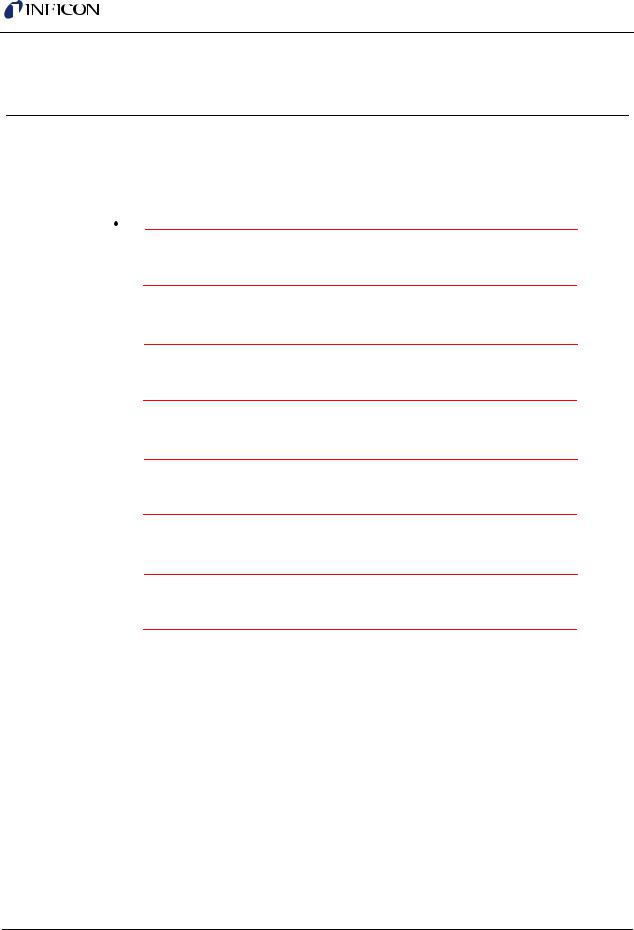
Transpector CPM Operating Manual
Chapter 1
Getting Started
1.1 General Safety Information
 WARNING
WARNING
Transpector CPM is not for use in a manner not specified by INFICON.
 WARNING - Risk Of Electric Shock
WARNING - Risk Of Electric Shock
There are no user serviceable components within the
Transpector CPM case.
 WARNING - Risk Of Electric Shock
WARNING - Risk Of Electric Shock
Potentially lethal voltages are present when the line cord is connected to Transpector CPM.
 WARNING - Risk Of Electric Shock
WARNING - Risk Of Electric Shock
Refer all Transpector CPM maintenance to qualified personnel.
1 – 1

Transpector CPM Operating Manual
1.2 Purpose of Transpector CPM
Transpector CPM samples a representative fraction of a process environment and directs the gas sample to a Residual Gas Analyzer (RGA). The CPM can detect levels of impurities in process gases at sub-ppm levels.
1.2.1 Description of the Transpector CPM
Transpector CPM is comprised of:
FabGuard® or FabGuard Explorer™ software provides automatic or manual control and status information. It includes a full array of basic residual gas analyzer (RGA) features, including Spectrum or Selected Peaks scanning, Leak Detection and Recipe Generation.
Quadrupole Sensor analyzes gases by: (1) ionizing the gas molecules,
(2) separating the ions by their mass-to-charge ratio, and (3) measuring the quantity of ions at each mass. The sensor can indicate the partial pressures of gases characteristic of processes occurring within a vacuum or other vessel, and is used to investigate the nature of a process or to monitor process conditions.
Electronics Module (Transpector®) controls the sensor. The electronics module and quadrupole sensor are a matched set. The electronics module attaches to and is supported by the sensor.
CPM Controller consolidates control functions into a single device. The CPM controller works in conjunction with the Transpector electronics module to control valve activation, heaters, pumps, and power to all elements of the system.
Pumping System provides process sampling from 1.5 atmospheres to high vacuum.
Inlet Valves, a HexBlock™ inlet provides several sampling ranges, a calibration reference, and a process pressure gauge.
1 – 2

Transpector CPM Operating Manual
1.3 Using this Operating Manual
Before using this manual, please take a moment to understand the Cautions and Warnings used throughout. They provide pertinent information that is useful in achieving maximum instrument efficiency while ensuring personal safety.
NOTE: Notes provide additional information about the current topic. HINT: Hints provide insight into product usage.
 CAUTION
CAUTION
Failure to obey these messages could result in damage to the sensor.
 WARNING
WARNING
Failure to obey these messages could result in personal injury.
 WARNING - Risk Of Electric Shock
WARNING - Risk Of Electric Shock
Potentially lethal voltages are present.
1 – 3

Transpector CPM Operating Manual
1.4 How to Contact INFICON
To contact INFICON regarding Transpector CPM, please use the following contact information:
INFICON, Inc.
Two Technology Place
East Syracuse, NY 13057 USA
Tel: +315.434.1100
Fax: +315.437.3803
E-mail: reachus@inficon.com
Worldwide customer support information is also available at www.inficon.com under Contact >> Support Worldwide
Sales and Customer Service
Technical Support
Repair Service
If experiencing a problem with Transpector CPM, please have the following information readily available:
The Transpector CPM serial number
A description of the problem
An explanation of any attempts at corrective action
The exact wording of any error messages received
1.4.1Returning Transpector CPM to INFICON
Do not return any component of the Transpector CPM to INFICON without first speaking with a Customer Support Representative. A Return Material Authorization (RMA) number must be obtained from the Customer Support Representative.
If a package is delivered to INFICON without an RMAnumber, the package will be held and customer contact will be made. This will result in delays in servicing Transpector CPM.
Prior to being given an RMA number, a Declaration Of Contamination (DOC) form may need to be completed if the sensor has been exposed to process materials. DOC forms must be approved by INFICON before an RMA number is issued.
INFICON may require that the sensor be sent to a designated decontamination facility, not to the factory.
1 – 4

Transpector CPM Operating Manual
1.5 Transpector CPM Performance Specifications
1.5.1 General Specifications
Table 1-1 General specifications
Mass Range (AMU) |
1 – 100 |
|
1 – 200 |
|
1 – 300 |
|
|
|
|
||
Resolution |
<1 AMU wide @ 10% peak height over entire mass range |
||||
|
(per AVS 1993 recommended practice) |
||||
|
|
||||
Total Pressure Range1 |
5x10-7–1x10-3 Torr (6.6x10-7–1.3x10-3 mbar) |
||||
Total Pressure |
±25% 1x10-6–1x10-3 Torr (1.3x10-6–1.3x10-3 mbar) |
||||
Accuracy2 |
|
|
|
|
|
Maximum Ion Source |
|
1x10-3 Torr (1.3x10-3 mbar) |
|
||
Operating Pressure3 |
|
|
|
|
|
Nominal Operating |
|
2x10-4 Torr (2.6x10-4 mbar) |
|
||
Pressure4 |
|
|
|
|
|
System Operating |
1x10-8 Torr (1.3x10-8 mbar)–1.2 atmospheres (with proper inlet configuration) |
||||
Pressure |
|
|
|
|
|
|
|
|
|
|
|
Sensitivity |
Amps/Torr (Amps/mbar) |
|
Amps/Torr (Amps/mbar) |
|
Amps/Torr (Amps/mbar) |
@ Low Emission |
>4x10-6 (>3x10-6) |
|
>2x10-6 (>1.5x10-6) |
|
>1x10-6 (>7.6x10-7) |
@ High Emission |
>2x10-5 (>1.5x10-5) |
|
>1x10-5 (>7.6x10-6) |
|
>5x10-6 (>3.8x10-6) |
Minimum Detectable |
1x10-13 Torr |
|
2x10-13 Torr |
|
4x10-13 Torr |
Partial Pressure5 |
(1.3x10-13 mbar) |
|
(2.6x10-13 mbar) |
|
(5.3x10-13 mbar) |
Maximum Data Rate |
|
|
1.8 ms per point |
|
|
(analog scans OR |
|
(555 data points per second) |
|
||
selected peaks) |
|
|
|
|
|
|
|
|
|
|
|
Abundance Sensitivity6 |
<5 ppm |
|
<10 ppm |
|
<100 ppm |
Zero Blast7 |
<2 ppm |
|
<25 ppm |
|
<200 ppm |
Detection Limit8 |
<1 ppm |
|
<2 ppm |
|
<4 ppm |
Linearity9 |
|
±20% |
|
|
|
1 – 5

Transpector CPM Operating Manual
Table 1-1 General specifications (continued)
|
Mass Range (AMU) |
1 – 100 |
|
1 – 200 |
|
1 – 300 |
|
|
|
|
|
|
|
Minimum Background |
|
|
1x10-8 Torr |
|
|
|
|
Pressure |
|
|
(1.3x10-8 mbar) |
|
|
|
Maximum Sensor and |
|
|
150°C |
|
|
|
Inlet Temperature |
|
|
|
|
|
|
|
|
|
|
|
|
1 |
Ion source pressure reading @ low emission using total pressure lens |
|
||||
2 Total pressure accuracy @ low emission |
|
|
|
|||
3 |
Maximum ion source operating pressure @ low emission |
|
||||
4 |
2x10-4 Torr in the ion source will produce about 1x10-5 Torr in the quadrupole region |
|
||||
5 |
MDPP at the ion source with EM on and 1 s dwell time |
|
|
|
||
6 |
Mass 40 contribution onto 41 AMU |
|
|
|
||
7 |
Zero blast contribution onto 2 AMU |
|
|
|
||
8 |
Minimal detectable concentration with Krypton in air @ a 1 s dwell time |
|
||||
9 |
For 1 Torr orifices and lower. Linearity @ low emission at 0.1 to 2 times the nominal orifice pressure |
|||||
|
|
|
|
|
|
|
1 – 6

Transpector CPM Operating Manual
1.5.2 Hex Block Orifice Sampling Inlets
Table 1-2 HexBlock inlets and available orifices (maximum nominal pressure for orifice)
Inlet |
Orifices |
|
|
V1 (LP) |
3 mTorr (no orifice) |
|
10 mTorr |
|
15 mTorr |
|
100 mTorr |
|
360 mTorr |
|
1 Torr |
|
|
V2 (HP) |
3 mTorr (no orifice) |
|
10 mTorr |
|
15 mTorr |
|
100 mTorr |
|
360 mTorr |
|
1 Torr (bypass) |
|
3 Torr (bypass) |
|
10 Torr (bypass) |
|
30 Torr (bypass) |
|
1 Torr Sniffer (bypass) |
|
3 Torr Sniffer (bypass) |
|
7 Torr Sniffer (bypass) |
|
10 Torr Sniffer (bypass |
|
30 Torr Sniffer (bypass) |
|
100 Torr Sniffer (bypass) |
|
|
V3 (HC) |
1 mTorr (High Conductance) |
|
|
1 – 7

Transpector CPM Operating Manual
1.5.3 Atmospheric Pressure (Capillary) Sampling
Table 1-3 Capillary sampling option
Process Pressure Range |
300 to 900 Torr (400 to 1199 mbar) |
(23oC ambient, no purge) |
|
Capillary Size and Lengths |
1/16 in. OD x 1.5 m SS capillary |
|
1/16 in. OD x 3.0 m SS capillary |
|
|
Process Gas Consumption |
2.6 sccm @ 300 Torr (400 mbar) |
|
17 sccm @ 760 Torr (1013 mbar) |
|
30 sccm @ 900 Torr (1199 mbar) |
|
|
Response Time for Composition |
Capillary Delay: t(1.5m) = 0.3 s |
Changes (response to normal inert |
t(3.0m) = 1 s |
gases) |
Intermediate Volume Tau = 0.7 s |
|
CPM Isolation time constant = 75 s |
|
|
1 – 8
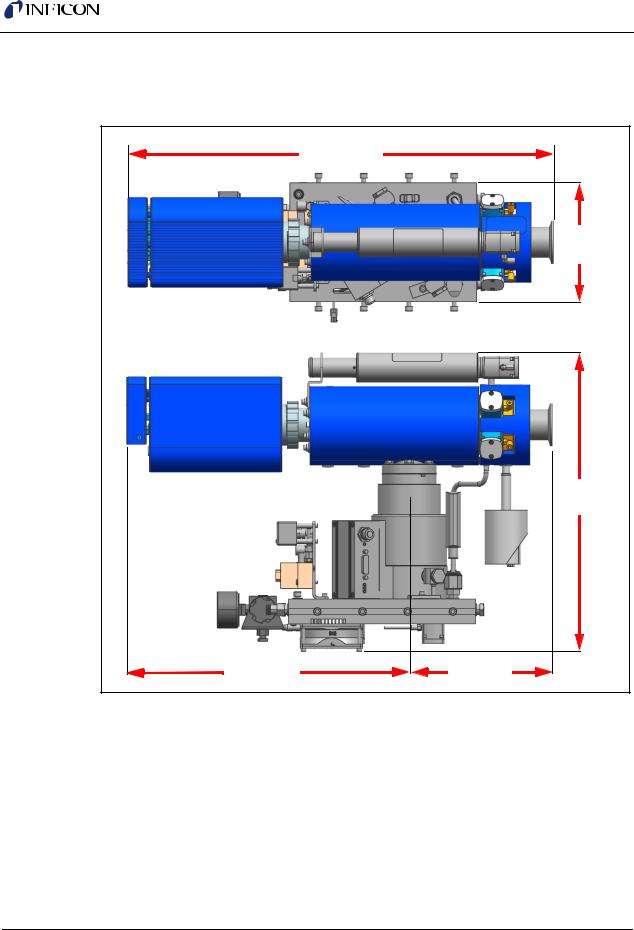
Transpector CPM Operating Manual
1.6 Physical Requirements
1.6.1 Physical Dimensions
Figure 1-1 Pumping system dimensions
|
545 mm |
|
(21.5 in.) |
|
152 mm |
|
(6.0 in.) |
|
378 mm |
|
(14.9 in.) |
362 mm |
183 mm |
(14.3 in.) |
(7.2 in.) |
Pumping System dimensions
545 x 152 x 378 mm (21.5 x 6.0 x 14.9 in.)
CPM Controller dimensions
195 x 207 x 89 mm (7.7 x 8.1 x 3.5 in.)
Foreline Pump dimensions
218 x 150 x 147 mm (8.6 x 5.9 x 5.8 in.)
NOTE: See Figure 2-8 on page 2-10 for cable connections.
1 – 9
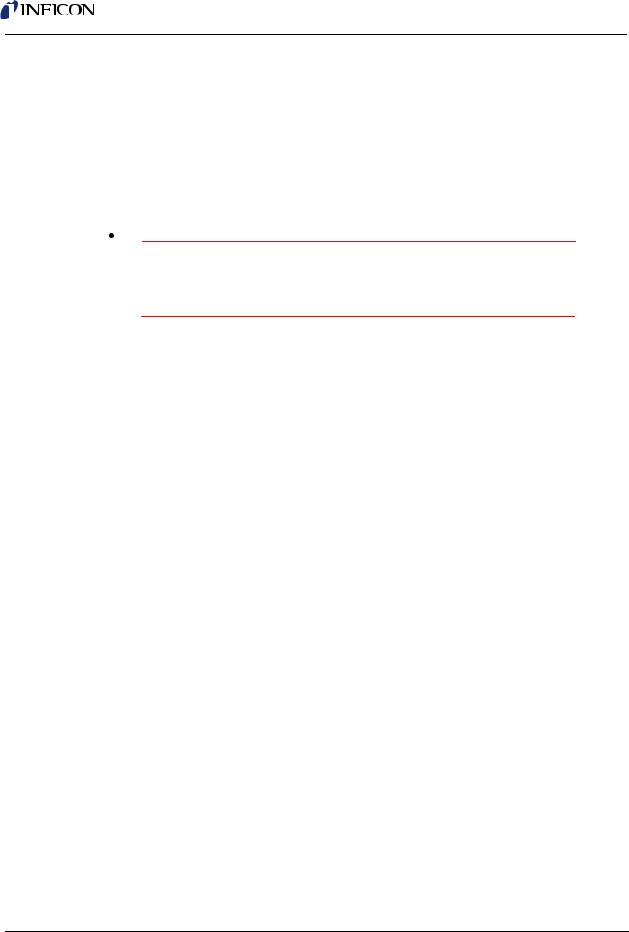
Transpector CPM Operating Manual
1.6.2 Weight
The approximate weight of Transpector CPM (without the Foreline Pump and the CPM controller) is 15.5 kg (34 lb.).
NOTE: This weight does not include connecting cables.
1.6.3 Ventilation Requirements
 CAUTION
CAUTION
Foradequate ventilation,maintain at least 25.4 mm(1 in.) clearance around the Transpector electronics module, the CPM heaters and the pumping system.
If enclosingTranspector CPM, the enclosure must be large enough or ventilated to provide adequate cooling airflow to the fan on the Transpector CPM pumping system and the fan in the Transpector CPM controller.
1.7 Electrical Power Requirements
The CPM system components that require AC power input are:
CPM controller . . . . . . . . . . . . . . . . . Universal input, any voltage in the range specified in section 1.7.1.1 is acceptable.
Personal computer . . . . . . . . . . . . . . Universal input, any voltage in the range specified in section 1.7.1.1 is acceptable.
1.7.1 Required Supply Voltage
Except for the AC power input, the CPM controller supplies all required voltages.
1.7.1.1 Acceptable Supply Voltage Range
The AC power input must be 100, 120, or 230 V~,±10%
NOTE: If the input power is less than 100 V~, the time required for the heaters to reach their nominal temperature will be increased.
1.7.1.2Required Frequency
50 or 60 Hz, ±5%
1.7.1.3Power Rating
CPM controller—500 VA
1 – 10

Transpector CPM Operating Manual
1.7.1.4Fuse Rating
3.15 A @ 250 V~
Interrupt Current 35 A @ 250 V~
Type T (5 x 20 mm)
1.7.1.5Overvoltage Category
Overvoltage Category II (per EN61010-1:2010)
Short Term: 1440 V < 2 seconds
Long Term: 490 V < 5 seconds
1.7.1.6Electrical Connections
One of the following:
110 V ~, three-pronged, grounded plug
230 V ~, European style, two-pronged plug with ground contact
NOTE: Do not replace power cord with an inadequately rated cord. Cord must be rated 10 A or higher.
1.8 Nitrogen Purge Gas (Corrosive System Only)
The corrosive service Turbo Molecular Pump requires 10 to 25 sccm nitrogen purge gas flow through its bearings to protect the bearings from corrosion and loss of lubricant by evaporation. The CPM nitrogen regulator range is
10–15 psi (gauge). It is set for 10 sccm flow at the factory.
 CAUTION
CAUTION
Thecorrosiveservice Turbo Molecular Pump(CVD/Etch), requires nitrogen purge gas flow whenever the system is operational.
Normally, dry nitrogen is supplied at the acceptable pressure range for the air pressure. (See section 1.10.1 on page 1-13). In this manner, dry nitrogen can be supplied directly to the solenoid valve block and to the pressure regulator via the supplied 6.35 mm (1/4 in.) tee. The regulator supplies dry nitrogen at a reduced pressure for the purge.
1 – 11
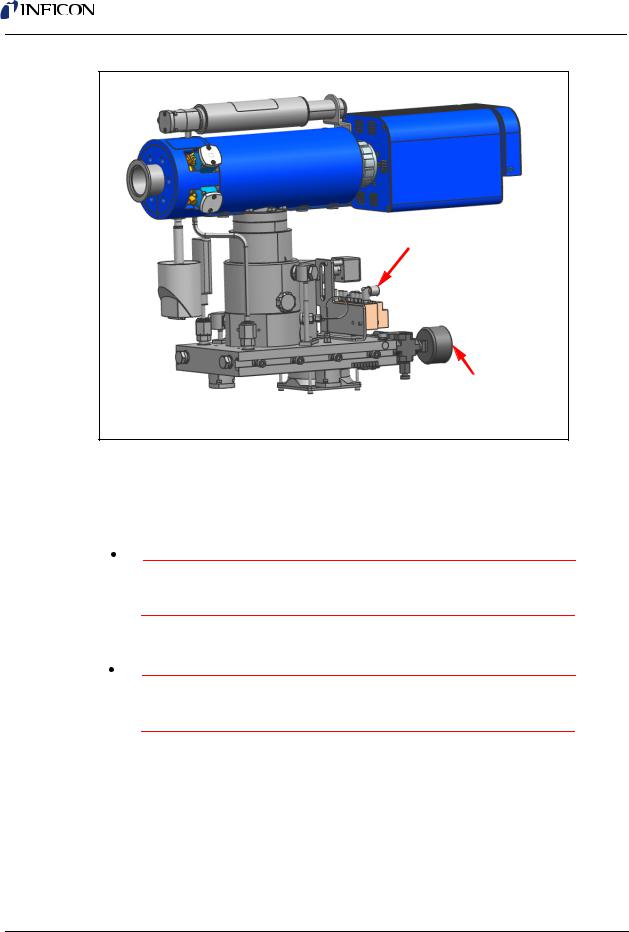
Transpector CPM Operating Manual
Figure 1-2 Compressed air supply connection
Dry Compressed Air  58–100 psi (gauge)
58–100 psi (gauge)
Recommended Setting is 75-80 psi (gauge)
Dry nitrogen 58–100 psi (gauge) Bearing Purge
Corrosive System Only
The pressure range is 58–100 psi (gauge) (4–6.9 bar) [400–690 kPa]. Recommended setting is 75-80 psi (gauge) (5.17 to 5.52 bar) [517 kPa to 552 kPa].
 WARNING
WARNING
Nitrogen pressure must not exceed 100 psi (gauge) (6.9 bar) [690 kPa].
 CAUTION
CAUTION
Nitrogen pressure must be at least 58 psi (gauge) (4 bar) [400 kPa].
1.9 Exhaust Gas
Exhausting gas from the Turbo Molecular Pump is required for corrosive applications. With non-corrosive applications, exhaust the Turbo Molecular Pump in accordance with the facility's requirements. The dry Foreline Pump has a 6.35 mm (1/4 in.) Swagelok® tube adapter for an exhaust fitting.
1 – 12
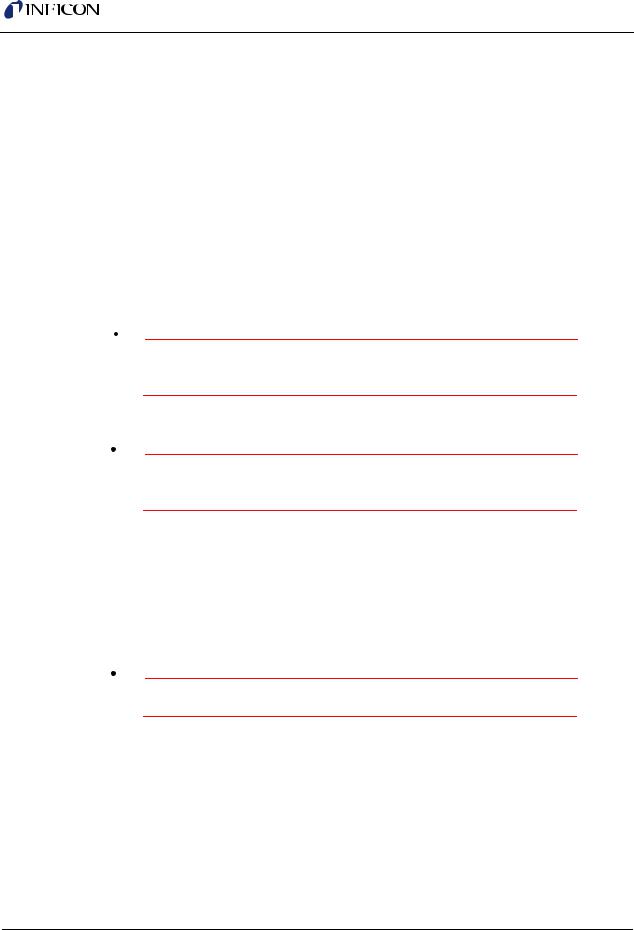
Transpector CPM Operating Manual
1.10 Air Pressure Requirements
1.10.1 Required Air Pressure
Dry compressed air (or dry nitrogen) is used to operate the electro-pneumatic inlet valves. The minimum air pressure required to operate the inlet valves is
58 psi (gauge) (4 bar) [400 kPa]. Recommended setting is 75-80 psi (gauge) (5.17 to 5.52 bar) [517 kPa to 552 kPa].
1.10.2 Air Pressure Range
The air pressure range is 58–100 psi (gauge) (4–6.9 bar) [400–690 kPa]. Recommended setting is 75-80 psi (gauge) (5.17 to 5.52 bar) [517 kPa to 552 kPa].
 WARNING
WARNING
Air pressure must not exceed 100 psi (gauge) (6.9 bar) [690 kPa].
 CAUTION
CAUTION
Air pressure must be at least 58 psi (gauge) (4 bar) [400 kPa].
1.10.3 Moisture Content of Compressed Air Supply
The compressed air supply used for inlet valve operation must be dried to the extent that changes in compressed air pressure during operation will not produce condensation in lines, solenoids or valve actuators.
 CAUTION
CAUTION
Moisture condensation can cause corrosion.
1.10.4 Air Pressure Connections
The compressed air supply connects to the CPM solenoid with 6.35 mm (1/4 in.) polymer hose. The 6.35 mm (1/4 in.) connector is a friction-lock, right-angle fitting to adapt the supply hose to the solenoid base.
1 – 13

Transpector CPM Operating Manual
1.11 Vacuum Requirements
1.11.1 Required Vacuum
TheTurboMolecularPumpandForelinePumpcreatevacuum.TheForelinePump must provide <10Torr (13 mbar) when thereisup to 30 sccm of nitrogenpurgeplus process gas bypass flow.
 CAUTION
CAUTION
Do not exceed 10 Torr (13 mbar) Foreline Pump pressure.
1.11.2 Acceptable Range Of Vacuum
TheCPMmanifoldcanachieve<1x10-8 Torr(1.33x10-8 mbar)ofbasepressure(no sample flow) after bakeout and cool down. This level of vacuum requires a foreline pressure of <10 Torr (13 mbar).
1.12 Environmental Requirements
1.12.1 Use
Indoor use only.
1.12.2 Altitude Range
Up to an altitude of 2000 m (6561 ft.)
Contact INFICON for operation at higher altitudes.
1.12.3 Maximum Humidity
80% relative humidity (no condensation)
1.12.4 Pollution Degree
Pollution Degree 2 (per EN61010-1:2001)
1.12.5 Maximum Operating Temperature
50°C (122°F) Transpector Electronics Module
35°C (95 °F) for the turbo pump under maximum gas load
1.12.6 Minimum Operating Temperatures
20°C (68°F)
1 – 14

Transpector CPM Operating Manual
1.12.7 Clean Room Requirements
The CPM is clean room compatible (including silicone rubber heaters).
1.12.8 Anti-Static Conditions
CPM passes standard EN 61326-1:2013.
1.13 Computer System Requirements
The minimum system requirements for FabGuard® Explorer Operating Software are listed in Table 1-4:
Table 1-4 Minimum computer requirements for FabGuard Explorer
Parameters |
FabGuard Explorer Requirements |
|
|
Processor |
2.4+ GHz Dual Core |
|
|
Memory |
4+ GB |
|
|
Hard Drive |
SATA 80 GB to 1 TB 7200+ RPM |
|
|
Resolution |
1024 X 768 16-bit color or greater |
|
|
Ethernet Port |
One free Ethernet port for connection to Transpector CPM |
|
|
Operating |
Windows 7® or Windows 8® |
System |
|
|
|
INFICON can supply a controller to run the software that operates
Transpector CPM System. (Refer to section 1.4 on page 1-4.)
1.13.1 Operating System
FabGuard Explorer software requires either Windows 7 or Windows 8 for proper operation.
See Chapter 10 or the FabGuard Explorer CD for FabGuard Explorer software operation.
1 – 15
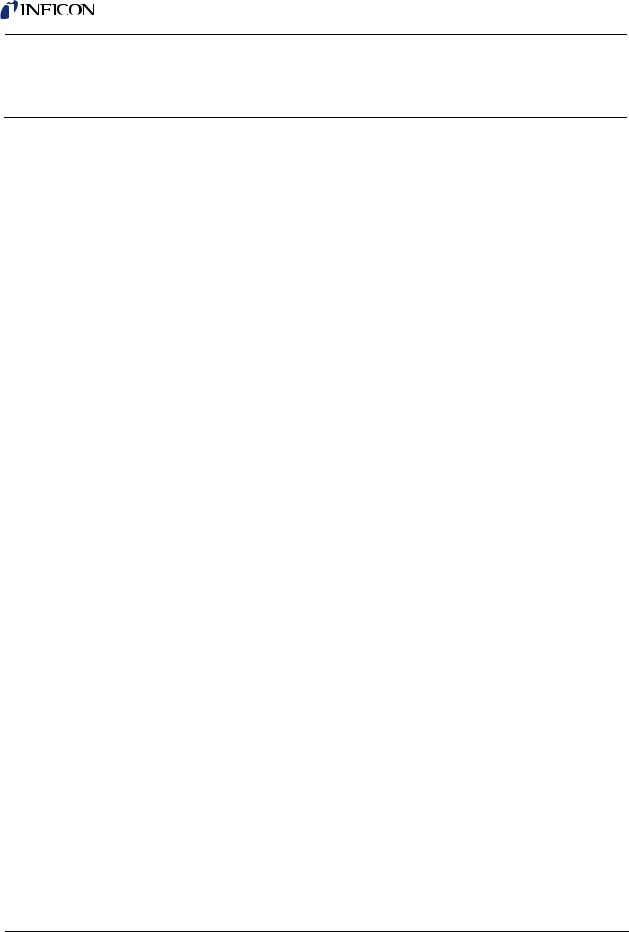
Transpector CPM Operating Manual
Chapter 2
Installation
2.1 Installation Overview
The Transpector CPM system is partially disassembled for shipping and must be re-assembled prior to operation. The Transpector sensor is shipped inside the CPM manifold tee, but the remaining components such as the Transpector electronics module, cable box, CPM controller, diaphragm foreline pump and all connecting cables will need to be installed per the instructions in this chapter:
1Install the Transpector electronics module, heat guard, and cable box. (See section 2.2 on page 2-2.)
2Install sniffers, if applicable. (See section 2.2 on page 2-2.)
3Mount CPM to process tool, if applicable. (See section 2.4 on page 2-5.)
4Install the CPM controller and connect communications cables from the CPM controller to the Transpector cable box (See Figure 2-6 on page 2-8.)
5Connect cables on theTranspector cable box to the various CPM sub systems, and the control computer. (See Figure 2-8 on page 2-10.)
6Install the CPM Foreline Pump. (See section 2.7 on page 2-11.)
7Install the software. (See section 2.8, Software Installation, on page 2-11.)
2 – 1
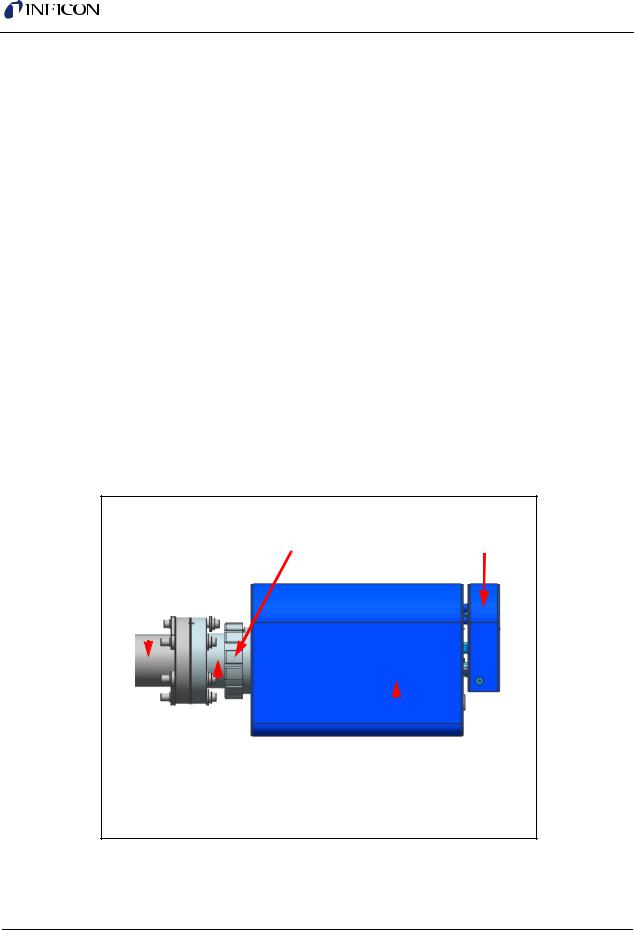
Transpector CPM Operating Manual
2.2 Transpector Electronics Module, Heat Guard, and Cable Box
Installation
The Transpector electronics module and cable box must be mounted in an area where the ambient temperature does not exceed 50°C (122°F) and there is ample air flow. Best performance is achieved when the electronics module is not exposed to wide temperature variations.
2.2.1 Attach Transpector Electronics Module
The Transpector sensor is typically already installed inside the CPM Manifold Tee. The Transpector electronics module must be mounted onto the sensor:
1TheTranspectorsensormountingconnectorassemblyincludesamountingnut and an O-ring. Place the nut over the end of the sensor and roll the O-ring back to the groove on the sensor. When the mounting nut is tightened, the O-ring compresses making a tight fit on the sensor housing.
2Note the recessed area on the sensor feedthrough and the ground tab on the Transpector electronics module. Match the recessed area of the feedthrough to the ground tab and carefully slide the Transpector electronics module fully onto the sensor.
3Finger tighten the mounting nut on the Transpector sensor.
Figure 2-1 Transpector electronics module dimensions
CPM Manifold Tee |
|
Mounting Nut |
|
Cable Box |
||
|
|
|
|
|
|
|
|
|
|
|
|
|
|
|
|
|
|
|
|
|
|
|
|
|
|
|
|
|
|
|
|
|
|
|
|
|
|
|
|
|
|
Transpector Sensor |
Transpector Electronics Module |
2 – 2

Transpector CPM Operating Manual
2.2.2 Attach Heat Guard
To decrease the risk of burns when the heating jacket is on, a heat guard is provided for the metal surfaces between the Transpector electronics box and the CPM manifold tee.
1Loosen the single screw that attaches the calibration reference shipping bracket to remove the bracket. Replace the screw.
2Attach heat guard between the Transpector electronics module and the mounting nut using the two screws provided.
3Attach calibration reference standard bracket to the heat guard and secure the bracket to the heat guard with the provided screw.
Figure 2-2 Heat Guard and Calibration Reference Bracket
Mounting Nut |
Calibration Reference |
|
Calibration Reference |
|||
|
Shipping Bracket |
|
Standard |
|
Bracket |
|
|
|
|
||||
|
|
|
|
|
|
|
|
|
|
|
|
|
|
|
|
|
|
|
|
|
Transpector Electronics Module |
Heat Guard |
 WARNING - High Temperature
WARNING - High Temperature
Metal surfaces will be hot when heating jacket is on. Attach heat guard to avoid risk of burns from metal surfaces between Transpector electronics module and CPM manifold tee.
2 – 3
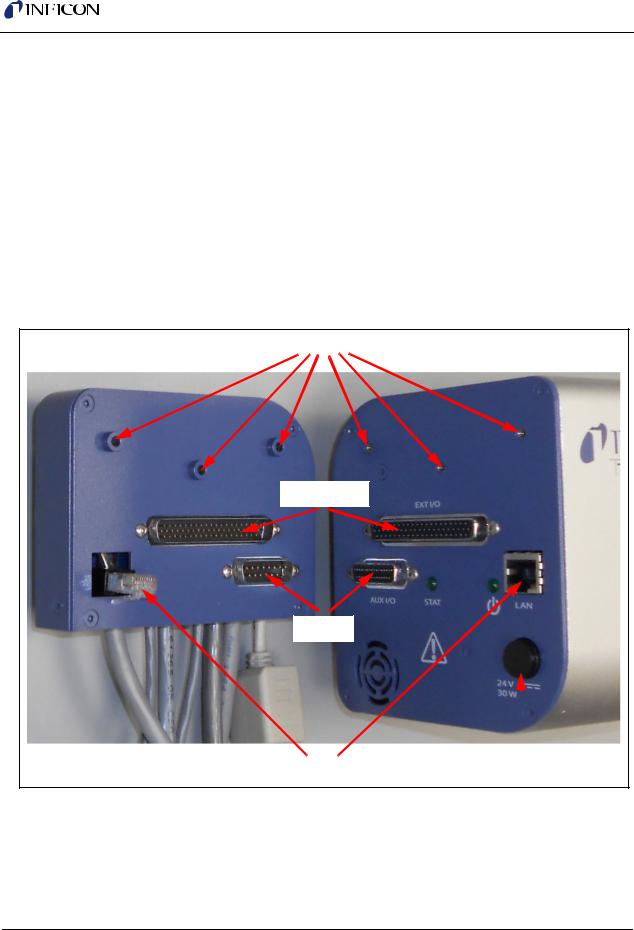
Transpector CPM Operating Manual
2.2.3 Attach Cable Box
The cable box and Transpector electronics module are connected via an Ethernet connection, a 15-pin Aux I/O connection, and a 62-pin extended I/O connection. Three screws are used to stabilize the cable box on the electronics module.
(See Figure 2-3.)
To connect the cable box to the electronics module:
1Insert the Ethernet jack on the cable box into the Ethernet port on the electronics module.
2Carefully insert the 15-pin Aux I/O and 62-pin extended I/O connectors until they are secure and the Ethernet connector snaps into place.
3Secure the cable box on the electronics module with the three provided screws.
Figure 2-3 Transpector electronics module and cable box
Screw Holes
Extended I/O
Aux I/O
|
|
|
|
Ethernet Connection |
Transpector 24V Input |
||
2 – 4
